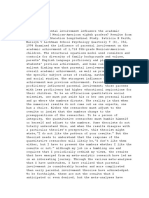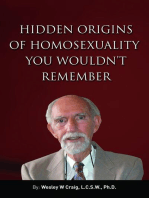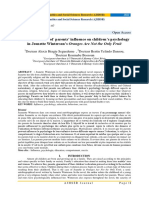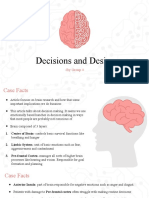Love and Attachments
Love and Attachments
Uploaded by
api-709737280Copyright:
Available Formats
Love and Attachments
Love and Attachments
Uploaded by
api-709737280Original Title
Copyright
Available Formats
Share this document
Did you find this document useful?
Is this content inappropriate?
Copyright:
Available Formats
Love and Attachments
Love and Attachments
Uploaded by
api-709737280Copyright:
Available Formats
It's funny because, at the beginning of this class, I was dreading reading this book thinking it
would be some useless comment on happiness with no logical or factual content. Still, the
author, Jonathan Haidt, does a remarkable job breaking down studies and research
experiments. Haidt was able to tie the research experiments and studies all together to build a
psychological evaluation. This psychological evaluation explains the reasoning behind human
nature and how they think, speak, and behave. I think the most interesting and
thought-provoking topic that the author covered in this chapter was the attachment theory.
The reason I found this so interesting is due to the way that it correlated with how a child-parent
relationship affects children once they have fully grown up. Now, of course, correlation doesn't
always equal causation. Many different factors play into the lasting effects that are imprinted on
children by their parents. It seems that showing physical affection and providing for a developing
child makes them more likely to be emotionally and even physically intact. A majority of the
studies Haidt referenced on the effects of motherhood as the caregiver, but there has been no
psychological evidence suggesting different attachment styles from the father. What I mean by
that is that there are three attachment styles as pointed out by Juli Fraga in her article titled,
How Parents are Made. These styles are secure, anxious, and avoidant. Children who showed
secure attachment were more likely to be secure in relationships as they aged, while children
who showed anxious tendencies tended to be more insecure in their partner's love for them
which can sometimes cause issues. Avoidant styles are much more apathetic and simply avoid
any attachment as they were left unsupported in their developmental years. As a result of
learning this information, I will ensure that if I am a parent I will ensure my child is not caudled
but very well supported and physically nurtured.
Another interesting thing I learned was the difference between lust, affection, and attachment
and their effects on a relationship. While Hadt covered this I learned most from Katherine Wu's
article titled Love, Actually: The science behind lust, attraction, and companionship. The
differences between these three things may be known when you look at them from afar but
when in a relationship sometimes they all blend together and it's not emotionally possible to tell
them apart. However, science tells us differently. Lust is primarily caused by hormones such as
testosterone and estrogen and makes people crave sex. Affection is caused by chemicals like
dopamine, norepinephrine, and seritonin. These things are released when we experience good
things related to a partner such as their attractive appearance, intimacy, or good discussion.
Finally, attachment is caused by oxytocin and vasopressin. These chemicals create less of an
emotional experience and more of a bond. This is most similar to a bond between a mother and
her child.
Sources
Fraga, J. (2020, September 28). How parents are made. Aeon.
https://aeon.co/essays/learn-your-own-attachment-style-to-become-a-better-parent?utm_source
=Aeon%2BNewsletter&utm_campaign=f04b685ac4-EMAIL_CAMPAIGN_2020_09_27_10_
48&utm_medium=email&utm_term=0_411a82e59d-f04b685ac4-69422937
Wu, K. (2017, February 14). Love, actually: The science behind lust, attraction, and
companionship. Science in the News.
https://sitn.hms.harvard.edu/flash/2017/love-actually-science-behind-lust-attraction-companions
hip/
You might also like
- Healing Sexual Trauma - Peter A. Levine PHDDocument6 pagesHealing Sexual Trauma - Peter A. Levine PHDcarryingwater91% (22)
- Wired For Love by Stan TatkinDocument23 pagesWired For Love by Stan TatkinNew Harbinger Publications65% (20)
- We Do: Saying Yes to a Relationship of Depth, True Connection, and Enduring LoveFrom EverandWe Do: Saying Yes to a Relationship of Depth, True Connection, and Enduring LoveNo ratings yet
- Bowlby - The Nature of The Child's Tie To His MotherDocument26 pagesBowlby - The Nature of The Child's Tie To His Motherinna_rozentsvit100% (1)
- 01.the Study of The Family - JacksonDocument10 pages01.the Study of The Family - JacksonErnesto ContrerasNo ratings yet
- First and Second Language Acquisition PDFDocument322 pagesFirst and Second Language Acquisition PDFFranciscoJosé100% (8)
- Bowen TheoryDocument6 pagesBowen TheoryTubocurare100% (2)
- iCARE PAPER Revised..editedDocument7 pagesiCARE PAPER Revised..editedMoffat HarounNo ratings yet
- Recognizing Child Abuse BrochureDocument3 pagesRecognizing Child Abuse Brochureapi-347454552No ratings yet
- Com330 Research PaperDocument9 pagesCom330 Research Paperapi-686924303No ratings yet
- Homosexuality 101: What Every Therapist, Parent, and Homosexual Should KnowDocument2 pagesHomosexuality 101: What Every Therapist, Parent, and Homosexual Should KnowAugusto CastellanoNo ratings yet
- Peer Pressure: But Everyone Was Doing It' Only 4% of Adolescents Are Able To Make Moral Decisions by Looking InwardDocument5 pagesPeer Pressure: But Everyone Was Doing It' Only 4% of Adolescents Are Able To Make Moral Decisions by Looking InwardkimaerielNo ratings yet
- Dirty MindsDocument7 pagesDirty MindsI Gede Agastya Darma LaksanaNo ratings yet
- Article - We Have ChemistryDocument3 pagesArticle - We Have ChemistrySimona TonciuNo ratings yet
- Copy of Final Paper For WordsssDocument5 pagesCopy of Final Paper For Wordsssa n g eNo ratings yet
- Attachment As An Organizational FrameworkDocument23 pagesAttachment As An Organizational FrameworkJotham TeoNo ratings yet
- 30 Days of Sex Talks TC 160720 578f9c21a4eabDocument2 pages30 Days of Sex Talks TC 160720 578f9c21a4eabjosephblessing1206No ratings yet
- Differences Between Men and WomenDocument2 pagesDifferences Between Men and Womenshiller100% (1)
- The Female Brain SummaryDocument4 pagesThe Female Brain SummaryMohammad Mehdi WahidNo ratings yet
- After Going Through This Module, You Are Expected To:: RelationshipDocument5 pagesAfter Going Through This Module, You Are Expected To:: RelationshipKatkat Cabangisan BulacNo ratings yet
- Empowered Love: Use Your Brain to Be Your Best Self and Create Your Ideal RelationshipFrom EverandEmpowered Love: Use Your Brain to Be Your Best Self and Create Your Ideal RelationshipRating: 4 out of 5 stars4/5 (1)
- Attachment Thesis TopicsDocument7 pagesAttachment Thesis Topicsginabuckboston100% (2)
- Relationship ReconstructionDocument32 pagesRelationship ReconstructionJulian Ratschiller100% (8)
- Theory For ResearchDocument7 pagesTheory For ResearchVanessa Fe DelidNo ratings yet
- Discuss A Sociocultural Approach To Personal RelationshipsDocument3 pagesDiscuss A Sociocultural Approach To Personal RelationshipsInaya nayyarNo ratings yet
- Teen Age RelationshipDocument21 pagesTeen Age Relationshippadillaganne365No ratings yet
- A Joosr Guide to... Attached by Rachel Heller and Amir Levine: The New Science of Adult Attachment and How it Can Help You Find—and Keep—LoveFrom EverandA Joosr Guide to... Attached by Rachel Heller and Amir Levine: The New Science of Adult Attachment and How it Can Help You Find—and Keep—LoveNo ratings yet
- Mind-blowing Relationship. Practical Tips To Rekindle Your Love LifeFrom EverandMind-blowing Relationship. Practical Tips To Rekindle Your Love LifeNo ratings yet
- Editorial EssayDocument4 pagesEditorial Essayapi-319333211No ratings yet
- Romantic Relationship ThesisDocument8 pagesRomantic Relationship Thesisfjm38xf3100% (2)
- MODULE 8 Personal Relationship SYNCRONOUSDocument31 pagesMODULE 8 Personal Relationship SYNCRONOUS2023800116No ratings yet
- Sex at Dawn by Christopher RyanDocument3 pagesSex at Dawn by Christopher Ryanrwritingandediting93No ratings yet
- How Parents Can Foster Friendship in Children: Begin a Meaningful Relationship With Your Child as Both Parent and Friend Without the Power Struggle: Best Parenting Books For Becoming Good Parents, #5From EverandHow Parents Can Foster Friendship in Children: Begin a Meaningful Relationship With Your Child as Both Parent and Friend Without the Power Struggle: Best Parenting Books For Becoming Good Parents, #5No ratings yet
- Books: Human Sexual Sponse, Companion To The One Being ReDocument3 pagesBooks: Human Sexual Sponse, Companion To The One Being Rea_different_nameNo ratings yet
- Empaths And Narcissists: How To Break Free From Narcissistic Abuse As A HSP, Recognize Them In Future, Escape Energy Vampires & Overcome Codependency & Overthinking In RelationshipsFrom EverandEmpaths And Narcissists: How To Break Free From Narcissistic Abuse As A HSP, Recognize Them In Future, Escape Energy Vampires & Overcome Codependency & Overthinking In RelationshipsNo ratings yet
- Par TheoryDocument3 pagesPar TheoryIrum SheikhNo ratings yet
- The Science of Love and Attraction - Mehmet Oktar GulogluDocument247 pagesThe Science of Love and Attraction - Mehmet Oktar Gulogluflaviaesc12No ratings yet
- Lesson 1Document79 pagesLesson 1Jeddah Lynn AbellonNo ratings yet
- G1 Soc Psych ResearchDocument6 pagesG1 Soc Psych ResearchJasmine MabanagNo ratings yet
- Hidden Origins of Homosexuality You Wouldn't RememberFrom EverandHidden Origins of Homosexuality You Wouldn't RememberRating: 1 out of 5 stars1/5 (4)
- Week 9 Personal RelationshipDocument5 pagesWeek 9 Personal RelationshipAbdelmar SusulanNo ratings yet
- Blaming The ParentDocument17 pagesBlaming The ParentbilalafsinNo ratings yet
- Love KernbergDocument12 pagesLove KernbergAmma Synkletyka100% (1)
- Patricia Puli, LPT: Prepared byDocument12 pagesPatricia Puli, LPT: Prepared byZhanell Mae Natividad100% (1)
- BOWLBY, J. 1958. The Nature of Child's Bond To His Mother.Document24 pagesBOWLBY, J. 1958. The Nature of Child's Bond To His Mother.Mariana AragónNo ratings yet
- PhilpaperDocument5 pagesPhilpaperapi-283548665No ratings yet
- What Is Personal RelationshipDocument10 pagesWhat Is Personal RelationshipyouthforyouthlanzonesNo ratings yet
- The Case Study of LoneDocument11 pagesThe Case Study of LoneAshley KateNo ratings yet
- Quarter 2 G2Document7 pagesQuarter 2 G2Maureen KeshaNo ratings yet
- Shielded Heart: How To Stop Yourself From Falling For A Seduction TargetFrom EverandShielded Heart: How To Stop Yourself From Falling For A Seduction TargetNo ratings yet
- Personal RelationshipDocument48 pagesPersonal Relationshipelisemartina08No ratings yet
- Too Scared of Tomorrow: A Clinical Approach to Understanding FearFrom EverandToo Scared of Tomorrow: A Clinical Approach to Understanding FearNo ratings yet
- Critical Overview of Parents' Influence On Children's Psychology in Jeanette Winterson's Oranges Are Not The Only FruitDocument7 pagesCritical Overview of Parents' Influence On Children's Psychology in Jeanette Winterson's Oranges Are Not The Only FruitAJHSSR JournalNo ratings yet
- Patterns of RelationshipsDocument11 pagesPatterns of RelationshipsEugene Eugenius Mask Maseko100% (2)
- Attachment Theory, The Science of Successful Relationships, Authentic Love, Romance and ConnectionFrom EverandAttachment Theory, The Science of Successful Relationships, Authentic Love, Romance and ConnectionNo ratings yet
- The Science of Soulmates: A Non-Fiction Guide to Finding Your True LoveFrom EverandThe Science of Soulmates: A Non-Fiction Guide to Finding Your True LoveNo ratings yet
- DoesdivorceaffectchildrenDocument7 pagesDoesdivorceaffectchildrenapi-319117298No ratings yet
- SW 122-Filipino Personality & Social Work Final RequirementDocument3 pagesSW 122-Filipino Personality & Social Work Final RequirementAmamore PlazaNo ratings yet
- 26 JulyDocument4 pages26 JulySamantha SchultzNo ratings yet
- Emily InforgraphicDocument1 pageEmily Inforgraphicapi-534129924No ratings yet
- Teaching Students With DisabilitiesDocument5 pagesTeaching Students With Disabilitiesapi-529723936No ratings yet
- P S Y C H O L O G I C Need Rest and Sleep Independent:: Nursing Care PlanDocument1 pageP S Y C H O L O G I C Need Rest and Sleep Independent:: Nursing Care Planunkown userNo ratings yet
- Mentally Challenged ChildDocument13 pagesMentally Challenged ChildUday KumarNo ratings yet
- Speaking CompetenceDocument289 pagesSpeaking Competencewisepupil0% (1)
- Dear Future SelfDocument6 pagesDear Future SelfJames Melo-Gurny BobbyNo ratings yet
- Williams & Grisham 2011 Compulsive BuyingDocument7 pagesWilliams & Grisham 2011 Compulsive BuyingMANUELNo ratings yet
- Training and Development in Indigo AirlinesDocument95 pagesTraining and Development in Indigo Airlinesbhartisuman75% (4)
- Rain Lesson PlanDocument4 pagesRain Lesson Planapi-357243074No ratings yet
- APC308 Financial Management April 2010 AssessmentDocument4 pagesAPC308 Financial Management April 2010 AssessmentmayatmanNo ratings yet
- Beck PublicationsDocument41 pagesBeck PublicationsDorottya Nagy0% (1)
- Balancing Rest, Relaxation, and Exercise For Effective Self-CareDocument2 pagesBalancing Rest, Relaxation, and Exercise For Effective Self-CareMax MaximNo ratings yet
- Wes2011 PDFDocument64 pagesWes2011 PDFclarkNo ratings yet
- Information Literacy - Context, Culture and Information SeekingDocument64 pagesInformation Literacy - Context, Culture and Information SeekingFlorence Margaret Paisey100% (1)
- Developing Key Account Management CompetencesDocument17 pagesDeveloping Key Account Management Competencesandualem workuNo ratings yet
- E-Mathematics 10: Grade 10. Rex Book Store, Inc. Grade 10. Rex Book Store, IncDocument5 pagesE-Mathematics 10: Grade 10. Rex Book Store, Inc. Grade 10. Rex Book Store, IncEm-jayL.SantelicesNo ratings yet
- Edited Negative Effects of Cyberbullying To The Students Mental Health of Bagong Silangan High School 1Document11 pagesEdited Negative Effects of Cyberbullying To The Students Mental Health of Bagong Silangan High School 1AlbenJames TabuldanNo ratings yet
- Health 8: I. Multiple Choice. Write The Letter of The Correct Answer in Your PaperDocument1 pageHealth 8: I. Multiple Choice. Write The Letter of The Correct Answer in Your PaperAbegail Pajarillo100% (2)
- Ps II RPT SummativeDocument6 pagesPs II RPT Summativeapi-484413318No ratings yet
- Decisions and Desire: - by Group 4Document46 pagesDecisions and Desire: - by Group 4Adarsh BansalNo ratings yet
- Proposal Template - Doc 1Document3 pagesProposal Template - Doc 1api-460203365No ratings yet
- Celebrities Reading TaskDocument3 pagesCelebrities Reading TaskAlexis Vladimir Cando OrtizNo ratings yet
- EOTG 1 Teacher BookDocument124 pagesEOTG 1 Teacher Booksu be bo100% (1)
- (Ethics) AttitudeDocument46 pages(Ethics) AttitudeAbhishek SinghNo ratings yet
- Problem Need TheoriesDocument32 pagesProblem Need TheoriesJames Kurt CruzatNo ratings yet

























































































